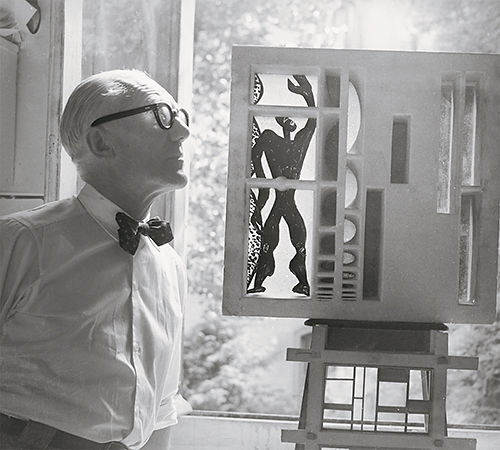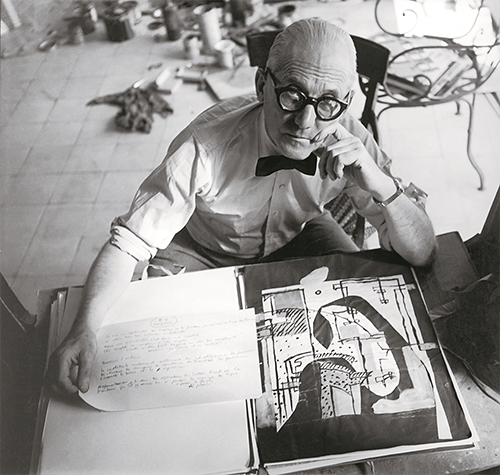Le Corbusier
Like many starting out in architecture, Le Corbusier made his name, not with finished buildings, but with bold ideas. After a rocky start, the Swiss French architect established himself in the mid 1920s with a series of texts, later collected in his 1923 book Vers une Architecture, or Toward an Architecture.It was in this book that Le Corbusier set out his Five Points of New Architecture, a set of principles that he thought new buildings should embody. These are: “the use of pilotis, or vertical piers, to raise structural volumes; the toît-jardin (roof garden); the plan libre (free plan); the fenêtre en longueur (ribbon window); and the façade libre (free facade).

The Man with a Hundred Faces, an essay by Jean-Louis Cohen.
By the 1930s, the physical image of Le Corbusier had become so identified with that of the modern architect that advertisements intended to appeal to members of the profession would show architects wearing circular, black-rimmed glasses and a bow tie, in imitation of the original. By this time Le Corbusier was a real media star: for almost six decades he never stopped mobilizing the press, radio, and film in support of his ideas and schemes. At first under his original identity—the name he was given at birth, Charles-Edouard Jeanneret – and then, from 1920, using his assumed name of Le Corbusier, he wrote thirty-four books containing some seven thousand pages of text, plus hundreds of articles and lectures that he presented in every continent except Australia. His dominant presence in the public sphere, combined with his fascination for technology and its objects, made him into a sort of total architect, deeply committed to the process of modernization.
The Visionary
By looking at the world, Le Corbusier expanded his horizons, with his focus pivoting to encompass a larger world: his attentive observation of the buildings of Florence continued in Germany and Central Europe, with further revelations in Istanbul and Athens. His interest in the metropolis, which he developed a taste for during the years before World War I, when he lived in Berlin and then in Paris for several months, broadened to include the rugged landscapes that he saw during his travels in Europe, an appreciation that was reinforced when he visited South America in 1929. But he continually changed his way of looking at urban scenes. His initial observations, made at ground level and written in letters and sketchbooks, were attuned to the picturesque: he sought out unusual shapes, contrasts, dissonances. When he started traveling by automobile, by boat, or by aircraft, the scale of his observations grew larger and, like so many others of his generation, he discovered the great urban patterns, the huge expanses of land, and the vast oceans, responding now to the sublime.

The Builder
Le Corbusier was driven to transform the physical world. His observations and notes are not those of an aesthete seeking knowledge or visual pleasure, but those of someone interested in construction. From his immersion in the world of clock and watchmaking, led Le Corbusier to open the “eyes that do not see” of his contemporaries to the new technological objects but to draw their attention to the character of contemporary building sites. Jeanneret set himself the challenge of reforming how buildings were constructed, devising the “Dom-ino” principle, the name of which— derived from the first syllables of the Latin word domus (house) and the French word innovation—itself suggested a program.
The Writer
Among Le Corbusier’s daily occupations, writing was unquestionably just as important to him as drawing. As a writer, he worked in a variety of registers, including private notes for his own use, articles for publications and texts for lectures, and books articulating his ideas, as well as an extensive correspondence. And the literary forms of this intense written output were no less diverse. More than any other architect of the twentieth century – with the exception of Frank Lloyd Wright – Le Corbusier was able to assemble, sometimes within one and the same text, erudite allusion, autobiographical reminiscence, a public harangue, and a critique of his contemporaries.

The Painter and Sculptor
From the first exhibition of his paintings in 1918, Le Corbusier never ceased throughout his life to insist on being recognized as an artist. He declared that painting, which he did every morning, was the “secret laboratory” in which he worked out many of the forms for his architectural projects, but he endeavored to make it an autonomous activity, and until 1930 he even signed his canvases with his original name rather than his assumed one. In purely quantitative terms, his output as an artist was substantial. He made more than four hundred paintings, eight thousand drawings, twenty-seven cartoons for tapestries, and forty- four sculptures. He also created engraved compositions on various materials and worked in enamel.
